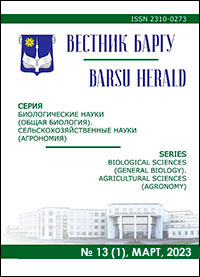TERRESTRIAL TRUE BUGS (HEMIPTERA: HETEROPTERA)OF NAROCHANSKY NATIONAL PARK
Keywords:
fauna; Hemiptera; Heteroptera; Narochansky national park; BelarusAbstract
The National Park “Narochansky” was established in 1999. It’s located on the territory of Minsk, Vitebsk and
Grodno regions, its area is 87,400 hectares. Insects are one of the least studied zoological objects in the National Park.
The taxonomic composition of terrestrial representatives of the suborder of hemipteran insects (Hemiptera: Heteroptera)
has been set up throughout the years of sporadic collections with the use of widely known and frequently used in entomological
studies methods, as well as the study of literary sources of the territory of the National Park “Narochansky”. A list
of 112 species of terrestrial true bugs belonging to 18 families has been prepared and submitted. For the first time, 70 species
of true bugs, one of which is Agnocoris reclairei (Wagner, 1949) from the Family Miridae, are mentioned. Before
that it was not found on the territory of the Republic of Belarus. The family Miridae dominates in the number of species —
50 species. The following species of Heteroptera have been found most often: Capsodes gothicus (Linnaeus, 1758), Capsus
ater (Linnaeus, 1758), Globiceps flavomaculatus (Fabricius, 1794) and Leptopterna dolabrata (Linnaeus, 1758)
(family Miridae), Anthocoris nemorum (Linnaeus, 1761) (family Anthocoridae), Stictopleurus punctatonervosus (Goeze,
1778) (family Rhopalidae), Aelia acuminata (Linnaeus, 1758), Carpocoris purpureipennis (De Geer, 1773), Dolycoris
baccarum (Linnaeus, 1758) and Eysarcoris aeneus (Scopoli, 1763) (family Pentatomidae).
Ref.: 17 titles.
Downloads
Published
Issue
Section
License
Copyright (c) 2023 Вестник БарГУ Серия "Биологические науки. Сельскохозяйственные науки"
Это произведение доступно по лицензии Creative Commons «Attribution-NonCommercial» («Атрибуция — Некоммерческое использование») 4.0 Всемирная.
Авторы сохраняют за собой право заключать определенные договорные соглашения, касающиеся неисключительного распространения опубликованной версии работы (например, размещать ее в институциональном репозитории, публикация в книге) со ссылкой на ее первоначальную публикацию в этом журнале.





